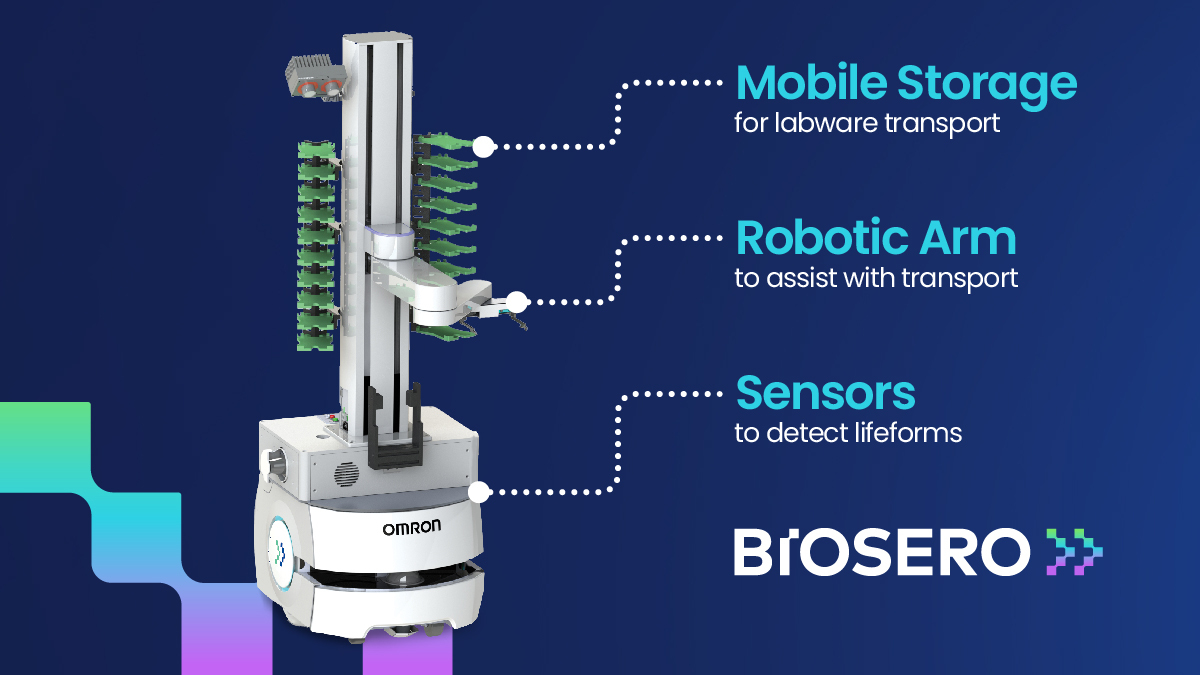An intro to mobile robots and why they are useful in the lab


For the automation engineers at Biosero, the idea of a mobile robot that’s collaborative, flexible, and able to help bridge the gap between different parts of the lab is revolutionary. It makes you think about droids from Star Wars that beep around star cruisers while executing their tasks, in harmony with the humanoids around them.
While we aren’t quite at the point of having sentient lab droids just yet, collaborative, flexible, and helpful robots are possible today through what we call “mobile robots.” And these robots have the ability to accelerate research timelines in unique ways.
To help you get more familiar with the technology, we’ll work through an introduction to modern-day mobile robots in this blog post, including their features and advantages for people who work in the lab.
What is a mobile robot?
A mobile robot these days generally includes a base to move the robot around the lab, a robotic arm to help with transportation of objects like plates and consumables, and a series of sensors that help the robot prevent collisions with lifeforms and inanimate objects.
Plus, at its heart, it has a computer that can connect with scheduling systems like Green Button Go to allow for optimal path planning plus clear directions for when to pick up and drop off just about anything you can imagine in the lab.
It might look something like this: 
If you want to see a mobile robot in action, here’s a great video showing how the mobile robot interacts with other transportation systems to pick up plates and move them to new devices.
What’s so great about a mobile robot?
There are all kinds of useful transportation methods to move materials already deployed in labs around the world, including robotic arms, conveyor belts, and track-based systems. These are all good options if you want to transfer, for example, a microplate from one device to another for processing. But, all of these methods need to be bolted down and lose all their flexibility from there. Reconfiguring their path can require your automation engineers or consultants like Biosero to come in and redesign the entire system.
That’s where the major benefits of the mobile robot really come in:
- Rapid deployment: Mobile robots are simple to implement since they don’t have to be bolted in place or set up next to lab equipment like conveyor belts. As long as your lab has a good internet connection, mobile robots can be installed and put to work quickly.
- Scalability: Mobile robots add next level flexibility to a lab. They are an easy way to connect stand-alone devices in the same lab or across labs. You can also seamlessly increase or decrease the number of mobile robots working in your labs at any given time. You can also assign robots to work exclusively on specific jobs or labs.
- Safety: Mobile robots use internal sensors and cameras to navigate and work in the lab environment. With some careful planning, you can work safely without worrying about robots bumping into you or your equipment.
- Easy to repurpose: Priorities are constantly shifting, and scientific workflows frequently need to be adapted, but moving fixed lab equipment can be tedious and expensive, and the process can risk damage to the instruments or components. With mobile robots, reconfiguring your workflow and repurposing your instruments is easier than ever.
- Integrates with scheduling software: Green Button Go scheduling software can work with every kind of mobile robot available today. If you already use Green Button Go in your lab, you don’t have to worry about purchasing separate software for new robots. We can easily incorporate mobile robots into new workflows.
Want to learn more?
Mobile robots are still relatively new to the laboratory space, so we’ve put together a few links and suggestions for how to get more familiar with the possibilities.
Manufacturer sites
We recommend researching mobile robot manufacturers as an important starting point. Biosero offers custom mobile robots, and we also work with mobile robot providers like Omron, Kevin Robot, and Astech to integrate their technology with Green Button Go.
More on mobile robots from Biosero
If you’d like to do more reading on mobile robots from the Biosero team, check out these links:
- How to decide if mobile robots are right for your lab
- How autonomous mobile robots improve lab workflows
- Mobile robots overview
Virtual or live tours with mobile robots integrated into Green Button Go systems
We love mobile robots here at Biosero, and that’s why we made our team mobile robot, Yoda, the concierge to the Biosero Acceleration Lab. You can visit San Diego, CA to get a live Acceleration Lab Tour to see Yoda in action, or we can set up a virtual tour. Either way, you can see for yourself just how a mobile robot fits into the laboratory environment and just how you’d program it for action.
Get Biosero’s help launching a mobile robot in your lab
If you want help implementing a mobile robot or a fleet of them in your lab, consider contacting an automation partner, like Biosero. We provide software and integration solutions to help labs achieve their workflow goals in lab automation, and mobile robots are just one very important part of the transportation picture. Reach out.


Want to automate smarter, not harder? Join the Biosero newsletter and stay in the loop with the latest lab automation strategies, success stories, and product updates.

